
Eryngium yuccifolium, known as rattlesnake master, button eryngo, and button snake-root, is a perennial herb of the parsley family native to the tallgrass prairies of central and eastern North America. It grows from Minnesota east to Ohio and south to Texas and Florida, including a few spots in Connecticut, New Jersey, Maryland, and Delaware.
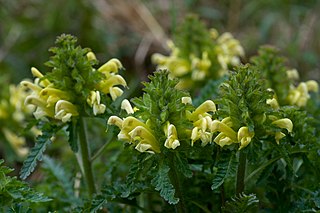
Pedicularis canadensis, commonly called Canadian lousewort or wood betony, is a flowering plant in the family Orobanchaceae. It is native to North America, where it is found in southeastern Canada, the eastern United States, and eastern Mexico. It has a wide-ranging natural habitat, being found in mesic to dry, forests, woodlands, and prairies.
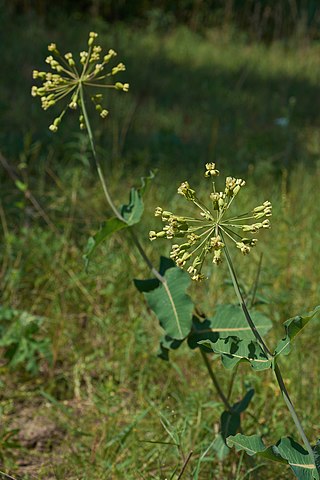
Asclepias amplexicaulis, the blunt-leaved milkweed, clasping milkweed, or sand milkweed, is a species of flowering plant in the subfamily Asclepiadoideae (Apocynaceae). It is endemic to the United States, where it is mostly found east of the Great Plains. It grows in dry prairies, savannas, open woods, and fallow fields, usually in sandy soil.

Primula meadia, known by the common names shooting star, eastern shooting star, American cowslip, roosterheads, and prairie pointers is a species of flowering plant in the primrose family Primulaceae. It is native to the eastern United States and Canada, spanning north from Manitoba and New York, south to Texas and Florida.

Symphyotrichum cordifolium, commonly known as common blue wood aster, heartleaf aster, and blue wood-aster, is a perennial herbaceous flowering plant in the family Asteraceae native to central and eastern North America. It reaches heights of up to 1.2 meters and has bluish daisy-like flowers which bloom late-summer and fall in its range.
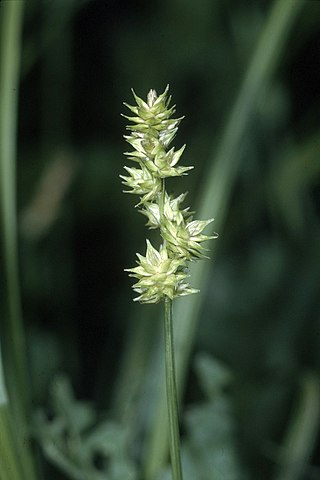
Carex sparganioides, known as bur-reed sedge or loose-headed bracted sedge, is a perennial plant belonging to the sedge family (Cyperaceae). Its native range includes most of the eastern and central United States and eastern Canada. In Maine, it is typically found in hardwood or mixed forests.

Carex inops is a species of sedge known as long-stolon sedge and western oak sedge. It is native to northern North America, where it occurs throughout the southern half of Canada and the western and central United States.
Herman Silas Pepoon (1860–1941), often known simply as H.S. Pepoon, was a prominent early botanist in the Chicago region. His 1927 Annotated Flora of the Chicago Region remains a classic of Chicago botany.
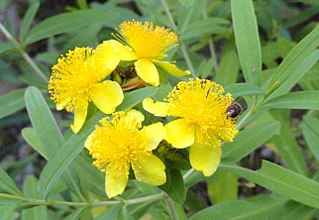
Hypericum kalmianum, commonly called Kalm's St. Johns wort or Kalm's St. Johnswort, is a flowering plant in the St. John's wort family Hypericaceae. It is native to the Great Lakes region in the northern United States and southern Canada. Hypericum kalmianum was named after its discoverer, Swedish botanist Pehr Kalm (1715-1779).
Gerould S. Wilhelm is an American botanist and lichenologist. He is known as author of several floras of the Chicago Region and the development of the Floristic Quality Assessment methodology, a tool to assess the integrity of natural areas. He is the director of research at Conservation Research Institute, a nonprofit organization "dedicated to the promotion of planning, design, restoration, and long-term management of sustainable ecological systems in built and natural environments through applied research, education, and outreach."

Hypericum swinkianum, known as Swink's St. John's wort, is a shrub in the St. John's wort family. It was named after Chicago Region botanist Floyd Swink (1921-2000).
Floyd Allen Swink (1921-2000) was an American botanist, teacher of natural history, and author of several floras of the Chicago region.

A remnant natural area, also known as remnant habitat, is an ecological community containing native flora and fauna that has not been significantly disturbed by destructive activities such as agriculture, logging, pollution, development, fire suppression, or non-native species invasion. The more disturbed an area has been, the less characteristic it becomes of remnant habitat. Remnant areas are also described as "biologically intact" or "ecologically intact."
Stephen Packard is an American conservationist, author, and ecological restoration practitioner active in the Chicago area.
Laura Rericha-Anchor is an American biologist with expertise in botany, ornithology, entomology, and ecology of the Midwestern United States.
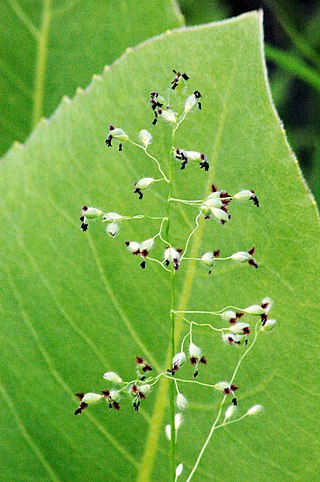
Dichanthelium leibergii, known as variously as Leiberg's panicum, Leiberg's panicgrass, Leiberg's rosette grass, and prairie panic grass is a species of grass native to North America. It was named for its discoverer, John Bernhard Leiberg (1853-1913), a Swedish-born American botanist active in the western United States.
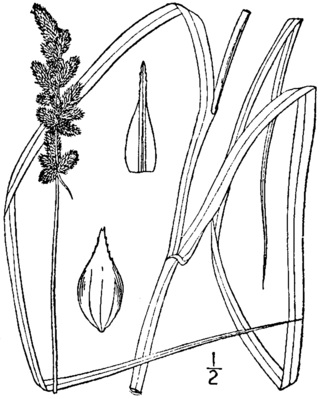
Carex annectens, sometimes called yellow-fruited fox sedge, is a species of sedge native to most of the eastern United States and southeastern Canada. It is common in prairies and high-water table fallow fields. In the Chicago area, its coefficient of conservatism is 3, and in Michigan, it is only 1, indicating its relatively low fidelity to high quality habitats.

Russell R. Kirt Prairie is a restored tallgrass prairie and savanna within the College of DuPage Natural Areas. A Trail Guide published by the college provides background information and ecological notes. In addition to the mesic prairie and oak savanna, the site also includes a small hill prairie, swale, marsh and wetland areas.

Bell Bowl Prairie is a remnant dry gravel prairie located on public land in Rockford, Illinois. It is considered a Category I Illinois Natural Areas Inventory (INAI) site due to its high quality natural community of native flora and fauna. It is currently owned by the Greater Rockford Airport Authority (GRAA), a public taxing agency in Winnebago County. According to GRAA, the prairie is "one of the best-preserved prairies in northern Illinois – a glimpse of the Rockford area prior to colonization".

Symphyotrichum kentuckiense is a rare species of flowering plant in the Asteraceae family and is commonly known as Kentucky aster, Price's aster, Miss Price's aster, Sadie's aster, or lavender oldfield aster. It is a perennial, herbaceous plant that is endemic to broken limestone cedar glades and roadsides in Alabama, Georgia, Kentucky, and Tennessee. It blooms from August through October, reaches heights between 30 centimeters and 100 cm (3.3 ft), and has green to reddish-brown stems. It is a nearly hairless plant with blue to blue-violet ray florets.

















